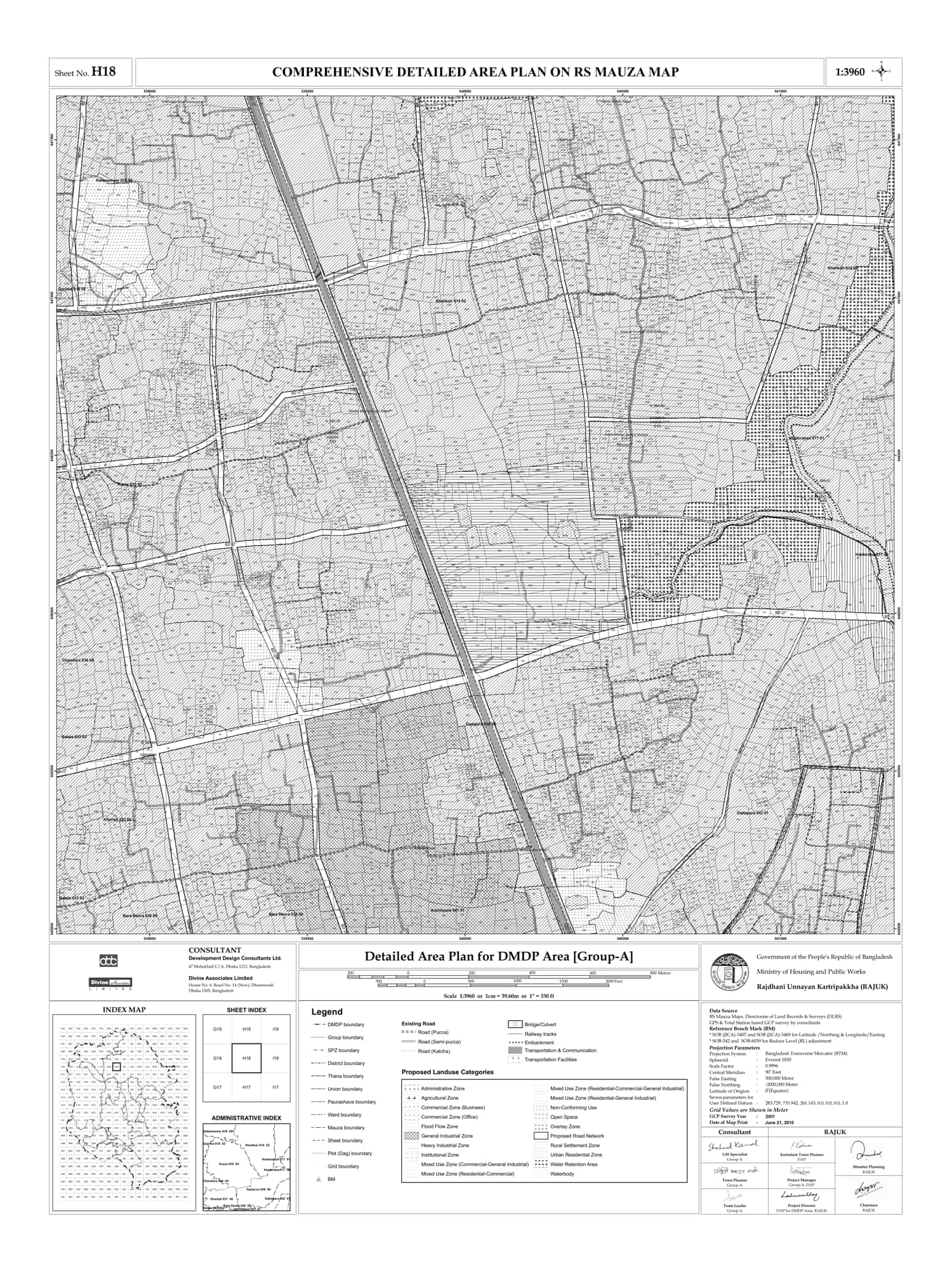-
Menu
-
Close

Dhaka, the “big apple” of Bangladesh, is home to over 23 million people and has been considered one of the most densely populated cities in the world for quite some time now. The centralizing effect of Dhaka City has boosted rapid growth, urbanization, and inadequate infrastructure causing numerous challenges to its locals, such as traffic congestion, air pollution, and a lack of affordable housing. Furthermore, it has deteriorated the quality of life by exacerbating the environmental conditions of the city.
To address these challenges, RAJUK has come up with the Detailed Area Plan (DAP) Map– DAP aims to provide a detailed framework for how land in certain areas of the city should be used and developed. The purpose of DAP is to guide and regulate seamless growth for the city, supporting urban decentralization.
By shifting economical, social, and political power away from the city limits to a more peripheral zone, the plan narrates the idea that Dhaka can become a sustainable city with improved living conditions for all its local residents.
In this article, I will elaborate on the facts of how DAP can drive urban decentralization in Dhaka. As well as, provide other insights, such as the new proposed DAP Map of Dhaka City and how it will help Dhaka become a more livable city square, and what could be the challenges if DAP is implemented successfully.
A Detailed Area Plan (DAP) typically contains detailed maps, zoning regulations, and land development guidelines specific to their designated area. In fact, it is often considered the master plan for the entire city and what it needs to develop itself with proper planning while promoting livability and sustainability.
By leveraging its benefits, cities worldwide have accelerated their growth keeping them aligned with the city’s broader objectives and vision. Ultimately, resulting in a better quality of living and a more efficiently planned city.
Singapore is one of the prime examples of implementing the DAP in each of its 55 planning areas, along with Vancouver, Sydney, and many other cities. The implementation of these plans has helped them to address issues such as housing affordability, environmental sustainability, and community livability, as well as achieving impressive results in terms of urban planning and development.
Urban decentralization can bring several advantages for cities like Dhaka, which has become densely populated and urbanized over the years due to economic growth. Such development has put excessive pressure on the city’s resources and infrastructure.
By decentralizing urban development, Dhaka can alleviate this pressure and achieve more balanced development throughout the country. Ultimately, it could reduce traffic congestion and improve access to resources and services in other regions.
Let’s look at the key benefits of Urban Decentralization:
Now, who wouldn’t want to live in a green and congestion-free Dhaka? That’s when the real beauty of the city pops out.
Even though the DAP is perfectly planned, it has some shortcomings that need to be addressed.

This improved DAP map covers an area of approximately 1,528 square kilometers, encompassing the city of Dhaka and its surrounding areas.
This map proposes the idea to create new residential areas and improve land development or expansion planning of existing areas. The plan is perfected to cater to the city’s ever-growing population, as well as the sustainability of the environment. As well as to resolve the ‘frustrating’ traffic congestion of Dhaka City by improving the development of transportation networks.
It has the potential to alter the urban landscape of the city and create a more livable environment for its residents, however, there’ll always be new challenges to changes, when the DAP gets implemented.
Despite the efforts and goals of DAP to make Dhaka more livable and sustainable, real estate experts are worried that it could disrupt the industry. Essentially, being aware of the new rules are necessary and how it could impact the real estate scenario in Dhaka.
Let’s take a look at the breakdown:
Realtors are concerned about the implementation of the Detailed Area Plan (DAP) in Dhaka and fear that the cost of flats will increase in the future. As a result, making housing is unaffordable for the middle class. However, the increase in flat prices may not be immediate but will happen eventually.
Even if DAP’s implementation may increase the flat prices, it is predicted to bring a positive change on the real estate market in the long term. As it can create a more organized and sustainable urban development plan, heading to the development of new areas in the city, which could help mitigate issues of overcrowdedness.
The goal of DAP is to provide affordable housing for the residents of the outskirts of Dhaka by implementing urban decentralization. However, it seems that the economic and political stability of Bangladesh and its potential impact on other industries may not have been taken into account. This flaw is particularly alarming for the industries linked with the real estate sector, which are anticipating incurring losses due to the DAP.
The recent increases in fuel prices and construction material costs have significantly driven up construction expenses. Therefore, the price of apartments is expected to rise, making it even harder for many people to afford a small-sized apartment or flat. Unfortunately, this contradicts the main objective, which is to promote equity and provide affordable housing for the masses.
The DAP regulations have the potential to cause some unhappiness amongst the landlords and tenants. However, landlords are likely to be hit the hardest. It is due to the minimum requirements for the number of apartments or flats they can construct on their property and the reduction of FAR means joint ventures with other real estate companies will be offered significantly less usable space (25%-40% lower) than before.
As a result, the cash flow generated is forecasted to be significantly low and is likely to not attract the landlords for a joint venture, making it difficult for the realtors.
And now, due to the limited number of apartments available for rent in the market, rental prices for flats are expected to go higher. Ultimately, leading to dissatisfaction for the tenants who would want to rent a home in a suitable place or location of their liking. The situation could get worse, as many realtors are not aware that DAP could influence such changes.
Let’s look at some of the challenges and limitations of properly implementing DAP for the purpose of urban decentralization in Dhaka:
As government officials influence the plans and transfer power and resources to local authorities, it may cause a challenge in DAP’s execution. As the local authorities lack the experience and capability to manage responsibilities. Moreover, there may be corruption under the table as well, which will cripple the whole idea behind DAP.
Due to weak institutional structures, inadequate staffing, and lack of technical expertise, it could result in an insufficiency of capable local government institutions in Dhaka, which is essential for decentralization. Furthermore, it will limit their ability to deliver the services required, and won’t be able to effectively respond to the community’s needs.
Local government authorities may lack the expertise to effectively make use of financial resources. As mentioned in the first point, it could lead to the misappropriation of funds and management resulting in corruption.
DAP could result in resistance amongst the people of the society, reluctant to change the stability of living with new development plans. This could result in dissatisfaction among the residents and may backlash to the implementation.
Even though there are challenges, limitations, and somewhat negative impacts of DAP’s urban decentralization in Dhaka, it is for the betterment of the city and the country’s growth.
Dhaka is the most densely populated and crowded city in the world, DAP’s map is the right initiative to make a planned growth towards the country’s future. It will bring new opportunities and scope for the people of Bangladesh, and step into a world of improved living with fewer crowds and a healthy atmosphere.
Urban decentralization can be characterized by five key attributes, transferring decision-making power to lower-level managers, quicker response times, expedited decision-making processes, the advancement of individual departments, and the involvement and growth of employees.
The primary goals of decentralization are to make public services better and to improve people’s lives.
The distribution of financial power, the delegation of administrative power, and the dispersion of political power.